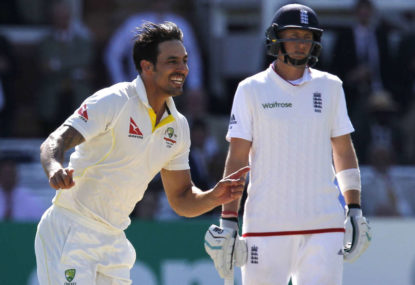Team of the Month: a May-born World Cricket XI
This series’ twelfth and final team has a distinct West Indian flavour at the top of the order, and a domineering captain.

Australia took a 239-run lead after the first innings of the first Test. With captain Steve Smith refusing to enforce the follow-on, Australia were left with little option but to bat again or abandon the Test.
They went with the former, ultimately wrapping up the Test by a margin of 208 runs.
Here are the ratings for the second innings of the first Test of the summer.
Joe Burns
Grade: B+
Returning to the crease, Joe Burns and David Warner racked up their second century-opening partnership of the Test, the first time this feat had ever been accomplished by an Australian opening pair.
Take that, Lawry and Simpson, Langer and Hayden, Taylor and Slater. After one lousy Test, you’ve already been trumped by Burns and Warner, who are now officially the greatest openers in Australian history.
It was Burns who dominated the partnership this time and, after spending one dot ball in the 90s sandwiched nervously between a pair of bludgeoned sixes, he brought up his first Test century off 102 balls.
Which is to say, this was his first Test century and it took him 102 balls to score it. Not that he’d scored many centuries previously, but this was the first time he’d done so in 102 balls. That would be a crazy stat to mention.
After a brief rain delay, Warner brought up his first Test century off 109 balls. He then attempted to switch hit himself out, finally succeeding when he was on 116.
Burns, alas, could only manage to be caught out in a conventional manner for 129, so he still has a little to learn from his more experienced partner.
Peter Nevill’s Invisibility Cloak
Grade: A
Did you know Peter Nevill played this Test?
It’s often said about wicketkeepers that they’re at their best when they’re unnoticed. If this is true, then Peter Nevill had a very good Test indeed. Not only did he draw no attention to himself in the keeping role, he also successfully avoided batting for a single delivery to truly ensure that he spent the entire match completely below the radar.
Less well hidden was Burns, who dropped virtually everything that came his way at short leg. If you can’t spell sidelined without Siddle, you certainly can’t spell butterfingers without Burns either.
Interestingly, you also can’t spell ‘anarchist’ without Starc, so expect some lawlessness over in the wild, wild west of the WACA second Test.
Scoreboard pressure
Grade: B+
After rain brought an early end to Day 3, Steve Smith declared overnight. As always, it’s reasonable to assume that he called the opposition captain at around 3am to announce this. If you’re going to declare overnight, do it in the most annoying way possible.
So, heading into Day 4 – traditionally the fourth day of the Test – New Zealand needed 504 to win. With over half a thousand runs needed for victory, the scoreboard pressure was immense.
Cricket is 10 per cent a technical game, 10 per cent a physical game, 90 per cent a mental game and, of course, minus 10 per cent a mathematically consistent game. But it’s that 90 per cent that causes most of the problems in such a mammoth run chase.
New Zealand fought hard, but once Kane ‘The Kane Plane’ Williamson departed shortly before the rain arrived late on Day 4, it was always going to be difficult for them to survive the final day.
Mitchell Johnson’s frugality
Grade: A
Mitchell Johnson has long been renowned as an explosive bowler who can change the game at any moment. And as far as coach Darren Lehmann was concerned as long as he didn’t change it to rugby union, Australia were going to be fine.
However, in the second innings here, he adopted a different role, helping to exacerbate the scoreboard pressure with a tight spell of bowling that didn’t see runs scored off him until his sixth over.
“He bowls to the centre
He bowls to the middle
This Mitchell Johnson
He’s bowling like Siddle”
DRS decisions
Grade: D
Brendon McCullum, a man who has never even heard of Faf du Plessis, attempted to save the game on the final day with an onslaught of power hitting.
But shortly after New Zealand had used their final review, McCullum was incorrectly given out caught off his pad by the ironically nicknamed Nigel ‘Never Wrong’ Llong. From there, any hope New Zealand had of saving the game was gone, and they eventually succumbed in the morning session.
While there was the usual immediate outcry for DRS to be abandoned, or strengthened, or weakened, or overhauled to a completely different form, the fact remained that New Zealand had used their reviews trying to save other batsmen from other, non-existent, errors. And this choice had come back to haunt them.
Overall, the tactical use of reviews make umpiring errors funnier and, hence, the game of cricket better. So I’m all for keeping DRS as it is.
And, having said all that, there was always the option for Smith to have called McCullum back to the crease. By which I mean Ian Smith, the heartbroken lone New Zealand commentator in the Channel Nine box.
Jimmy Neesham palindromes
Grade: E (darg)
Jimmy Neesham has been ruled out of the rest of the tour with injury. A shame, because I never got to use my favourite palindrome, celebrating the exquisite nature of his aggressive batting.
“Orgasm! Ah… See Neesham’s agro.”